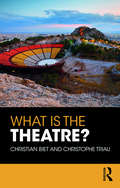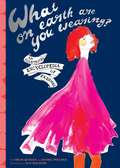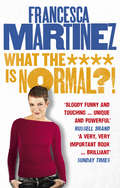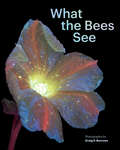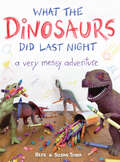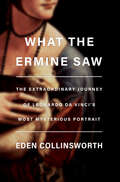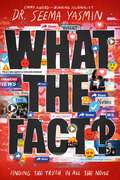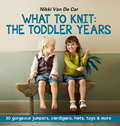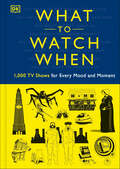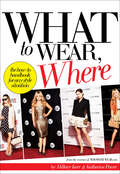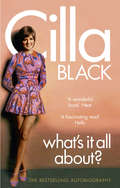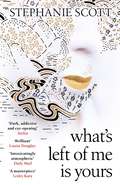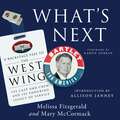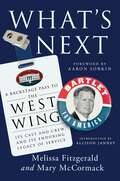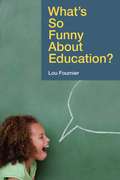- Table View
- List View
What is a Picture?
by Michael NewallWhat is a picture? Is it a symbol, a likeness, a trigger of certain visual experiences or cognitive states? Each of these ideas, wrongly placed in competition by earlier theorists, gives some insight into what a picture is. This book draws together, criticises and refines these ideas to develop a new theory of pictures, that understands pictures to be an intrinsically visual from of representation. Using an approach deeply informed by art history and perceptual psychology, it explores the ramifications such a theory has for the visual arts, developing a new theory of pictorial realism, reconsidering the special status often granted to perspective-based realism in art, and giving a powerful new analysis of abstraction in modern painting.
What is a Playhouse?: England at Play, 1520–1620
by Callan DaviesThis book offers an accessible introduction to England’s sixteenth- and early seventeenth-century playing industry and a fresh account of the architecture, multiple uses, communities, crowds, and proprietors of playhouses. It builds on recent scholarship and new documentary and archaeological discoveries to answer the questions: what did playhouses do, what did they look like, and how did they function? The book will accordingly introduce readers to a rich and exciting spectrum of "play" and playhouses, not only in London but also around England. The detailed but wide-ranging case studies examined here go beyond staged drama to explore early modern sport, gambling, music, drinking, and animal baiting; they recover the crucial influence of female playhouse owners and managers; and they recognise rich provincial performance cultures as well as the burgeoning of London’s theatre industry. This book will have wide appeal with readers across Shakespeare, early modern performance studies, theatre history, and social history.
What is the Theatre?
by Christian Biet Christophe TriauWhat is the Theatre? is one of the most coherent and systematic descriptions and analyses of the theatre yet compiled. Theatre is, above all, spectacle. It is a fleeting performance, delivered by actors and intended for spectators. It is a work of the body, an exercise of voice and gesture addressed to an audience, most often in a specific location and with a unique setting. This entertainment event rests on the delivery of a thing promised and expected – a particular and unique performance witnessed by spectators who have come to the site of the performance for this very reason. To witness theatre is to take into account the performance, but it is also to take into account the printed text as readable object and a written proposition. In this book, Christian Biet and Christophe Triau focus on the practical, theoretical and historical positions that the spectator and the reader have had in relation to the locations that they frequent and the texts that they handle. They adopt two approaches: analysing the spectacle in its theatrical and historical context in an attempt to seek out the principles and paradigms of approaching the theatre experience on one hand, and analysing the dramaturgy of a production in order to establish lines of interpretation and how to read, represent and stage a text, on the other. This approach allows us to better understand the ties that link those who participate in the theatre to the practitioners who create theatrical entertainment.
What on Earth Are You Wearing?
by Daniel Pollock Chloe QuigleyEvery fashionista worth her Louboutins cares as much about a book's outfit as she does about its content. This purse-sized encyclopedia dons a cloth cover stamped with shimmering silver foil and a satin-ribbon page marker. Alongside vibrant illustrations, a team of fashion forecasters defines more than 285 terms from acid wash to zebra ("fatigues are really just exhausted clothes") and answers sartorial quandaries ("What do I do when I've bought a genuine 'Channel' handbag in Hong Kong?"). Equally snarky and stylish, this insider's guide is sure to be on all of this season's best-dressed lists.
What the **** is Normal?!
by Francesca MartinezIf you grow up in a world where wrinkles are practically illegal, going bald is cause for a mental breakdown, and women over size zero are encouraged to shoot themselves (immediately), what the hell do you do if you’re, gasp … DISABLED? Whatever body you’re born into, the pressure to be normal is everywhere. But have you ever met a normal person? What do they look like? Where do they live? What do they eat for breakfast?And what the **** does normal mean anyway?This is the award-winning wobbly comedian Francesca Martinez’s funny, personal, and universal story of how she learned to stick two shaky fingers up to the crazy expectations of a world obsessed with being ‘normal’.
What the Bees See
by Craig P. BurrowsDiscover the magical world of the honeybee with this deluxe book, featuring 70 stunning images shot with ultraviolet technology.A comprehensive look into the amazing science of bees, this book collects mesmerizing ultraviolet-induced visible fluorescence (UVIVF) photography of flowers and nature and offers fascinating research that explores every aspect of our relationship with honeybees. Learn about the history of beekeeping, current environmental impacts affecting bees, and the rise of bee products in medical and wellness spaces. As you travel through the world of bees, you'll discover a diverse range of flora showcased in a whole new light through the ultraviolet spectrum, from orchids and anemones to manuka and cactus blossoms. A gorgeous gift for environmentalists and photography fans alike, this in-depth book invites us to reimagine the world from a bee's point of view and better understand its importance to the future of all life on earth.PHENOMENAL NATURE IMAGERY: Craig P. Burrows has been specializing in UVIVF photography for nearly a decade, and this book includes 70 incredible photos taken using this innovative technique. Burrow's luminescent images capture the magic of nature and showcase flowers glowing in otherworldly blues and teals, simulating how bees and other pollinators become attracted to the plants.GET THE BUZZ ABOUT BEES: In addition to the incredible UV photography, this book features engaging illustrations and infographics, archival and historical images, and original interviews with over forty of the world’s leading experts on bees and bee products. Organized into three distinct sections on bee ecosystems, bee products and cultivation, and modern medical and wellness advances tied to bees, this in-depth book illuminates the extraordinary role the honeybee has played throughout history and will answer questions you didn’t even know you had.SUSTAINABILITY GIFT BOOK: This deluxe photobook is a great gift for nature lovers, bee and beekeeping enthusiasts, and anyone who cares about environmental conservation and preservation. Add it to the shelf with books like the National Geographic Photo Ark series by Joel Sartore and DK's The Bee Book.Perfect for:Bee, insect, and bug enthusiastsNature lovers and environmental activistsFlower and nature photography loversPeople interested in learning about bee products used in medicine, wellness, and skincare People interested in UVIVF technology and innovative photography techniquesFans of nature documentaries like David Attenborough’s Life In Color seriesFans of Craig P. Burrows's research and photography
What the Dinosaurs Did Last Night
by Refe Tuma Susan TumaFrom the parents who brought us the web sensation "Dinovember" comes photographic proof of what toys do at night. Since Toy Story (and maybe since the very first toys!) children and their parents have wondered what it would be like if toys came to life. Refe and Susan Tuma take this wonder several steps further in WHAT THE DINOSAURS DID LAST NIGHT.Every November, writer and social media master Refe Tuma and his wife, Susan, work into the night to bring their four children scenes from the secret lives of their toys -- specifically the nighttime antics of their plastic dinosaurs. The dinosaurs wreck bathrooms, destroy vases, rock out, encounter terrifying hot irons, even do the dishes with hilarious, magical results. Each scene is photographed in meticulous detail, letting viewers joyfully suspend disbelief and think to themselves -- just LOOK what the dinosaurs did last night!
What the Dogs Taught Me: Observations and Suggestions That Will Make You a Better Hunter, Shooter, and Dog Owner
by Scott Linden“My dogs and I get along best when I hit the birds they produce for me. Putting the odds in my favor is the least I can do. Now, so can you.”If you hunt for pheasants, grouse, quail, and other upland birds, forming a partnership with your dog can be a daunting challenge. Wingshooting USA’s Scott Linden is here to help. What the Dogs Taught Me fills in the blanks for the wingshooter and dog owner with solid advice that will improve dog and hunter’s levels of communication, respect, and hunting efficiency.With lessons on dogs’ desires, skills, and abilities to learn, care and feeding, health and safety, preparation, and shooting, What the Dogs Taught Me is the ultimate guide to maximizing happiness and minimizing frustration whether out on the hunt or relaxing in the backyard. Even better, Linden’s lovable, often hilarious tone makes taking advice on training, strategizing, and partnership enjoyable to human and canine alike.Don’t be a student at the school of hard knocks—What the Dogs Taught Me advances an upland hunter’s skills quickly, creatively, and without any of the angst of more difficult methods.
What the Ermine Saw: The Extraordinary Journey of Leonardo da Vinci's Most Mysterious Portrait
by Eden CollinsworthThe remarkable true story behind one of history&’s most enigmatic portraits—"a glorious picaresque of unbridled passions and unmitigated scoundrels, a glorious romp through the great palaces and palazzos of Europe" (Amanda Foreman, New York Times best-selling author of Georgiana, Duchess of Devonshire)Five hundred and thirty years ago, a young woman sat before a Grecian-nosed artist known as Leonardo da Vinci. Her name was Cecilia Gallerani, and she was the young mistress of Ludovico Sforza, duke of Milan. Sforza was a brutal and clever man who was mindful that Leonardo&’s genius would not only capture Cecilia&’s beguiling beauty but also reflect the grandeur of his title. But when the portrait was finished, Leonardo&’s brush strokes had conveyed something deeper by revealing the essence of Cecilia&’s soul. Even today, The Woman with an Ermine manages to astonish. Despite the work's importance in its own time, no records of it have been found for the two hundred and fifty years that followed Gallerani&’s death. Readers of The Hare with the Amber Eyes will marvel at Eden Collinsworth&’s dexterous story of illuminates the eventual history of this unique masterpiece, as it journeyed from one owner to the next–from the portrait&’s next recorded owner, a Polish noblewoman, who counted Benjamin Franklin as an admirer, to its exile in Paris during the Polish Soviet War, to its return to WWII-era Poland where—in advance of Germany&’s invasion—it remained hidden behind a bricked-up wall by a housekeeper who defied Hitler&’s edict that it be confiscated as one of the Reich&’s treasures. Fans of Anne-Marie O&’Connor&’s The Lady in Gold will treasure the story of this criss-crossing journey and the enigmatic woman at its heart. What the Ermine Saw is a fact-based story that cheats fiction and a reminder that genius, power, and beauty always have a price.
What the Eye Hears: A History of Tap Dancing
by Brian SeibertThe first authoritative history of tap dancing, one of the great art forms—along with jazz and musical comedy—created in America.Finalist for the National Book Critics Circle Award in NonfictionWinner of Anisfield-Wolf Book AwardAn Economist Best Book of 2015What the Eye Hears offers an authoritative account of the great American art of tap dancing. Brian Seibert, a dance critic for The New York Times, begins by exploring tap’s origins as a hybrid of the jig and clog dancing and dances brought from Africa by slaves. He tracks tap’s transfer to the stage through blackface minstrelsy and charts its growth as a cousin to jazz in the vaudeville circuits. Seibert chronicles tap’s spread to ubiquity on Broadway and in Hollywood, analyzes its decline after World War II, and celebrates its rediscovery and reinvention by new generations of American and international performers. In the process, we discover how the history of tap dancing is central to any meaningful account of American popular culture.This is a story with a huge cast of characters, from Master Juba through Bill Robinson and Shirley Temple, Fred Astaire and Ginger Rogers, and Gene Kelly and Paul Draper to Gregory Hines and Savion Glover. Seibert traces the stylistic development of tap through individual practitioners and illuminates the cultural exchange between blacks and whites, the interplay of imitation and theft, as well as the moving story of African Americans in show business, wielding enormous influence as they grapple with the pain and pride of a complicated legacy. What the Eye Hears teaches us to see and hear the entire history of tap in its every step.“Tap is America’s great contribution to dance, and Brian Seibert’s book gives us—at last!—a full-scale (and lively) history of its roots, its development, and its glorious achievements. An essential book!” —Robert Gottlieb, dance critic for The New York Observer and editor of Reading Dance“What the Eye Hears not only tells you all you wanted to know about tap dancing; it tells you what you never realized you needed to know. . . . And he recounts all this in an easygoing style, providing vibrant descriptions of the dancing itself and illuminating commentary by those masters who could make a floor sing.” —Deborah Jowitt, author of Jerome Robbins: His Life, His Theater, His Dance and Time and the Dancing Image
What the Fact?: Finding the Truth in All the Noise
by Seema YasminFrom acclaimed writer, journalist, and physician Dr. Seema Yasmin comes a &“savvy, accessible, and critical&” (Kirkus Reviews, starred review) book about the importance of media literacy, fact-based reporting, and the ability to discern truth from lies.What is a fact? What are reliable sources? What is news? What is fake news? How can anyone make sense of it anymore? Well, we have to. As conspiracy theories and online hoaxes increasingly become a part of our national discourse and &“truth&” itself is being questioned, it has never been more vital to build the discernment necessary to tell fact from fiction, and media literacy has never been more important. In this accessible guide, Dr. Seema Yasmin, an award-winning journalist, scientist, medical professional, and professor, traces the spread of misinformation and disinformation through our fast-moving media landscape and teaches young readers the skills that will help them identify and counter poorly-sourced clickbait and misleading headlines.
What the Music Said: Black Popular Music and Black Public Culture
by Mark Anthony NealFirst Published in 1999. Routledge is an imprint of Taylor & Francis, an informa company.
What to Knit When You're Expecting: Simple Mittens, Blankets, Hats And Sweaters For Baby
by Nikki Van De CarNikki Van De Car spent the months before her daughter's birth knitting constantly to keep her hands busy and to help the time before her arrival pass more quickly. She knitted everything from sweaters and hats to burp cloths and stuffed animals. Over the course of the following year, she learned which items were actually useful, and which sat in a drawer, never to be worn. The 28 patterns collected in 'What to Knit When You're Expecting', for babies aged from 0 to 12 months, are the best of these, and include booties, mittens, bibs and blankets, as well as sweaters, hats and cardigans. All are relatively simple, so can be knit while your mind is elsewhere, and all are immensely practical. This title is organized according to where you are in your pregnancy, the patterns for the first trimester reflect the fact there is still plenty of time to finish a longer project; those for the second, when many women learn the sex of their baby, focus on clothes for girls and boys; and projects for the third are quick and easy.
What to Knit When You're Expecting: Simple Mittens, Blankets, Hats And Sweaters For Baby
by Nikki Van De CarNikki Van De Car spent the months before her daughter's birth knitting constantly to keep her hands busy and to help the time before her arrival pass more quickly. She knitted everything from sweaters and hats to burp cloths and stuffed animals. Over the course of the following year, she learned which items were actually useful, and which sat in a drawer, never to be worn. The 28 patterns collected in 'What to Knit When You're Expecting', for babies aged from 0 to 12 months, are the best of these, and include booties, mittens, bibs and blankets, as well as sweaters, hats and cardigans. All are relatively simple, so can be knit while your mind is elsewhere, and all are immensely practical. This title is organized according to where you are in your pregnancy, the patterns for the first trimester reflect the fact there is still plenty of time to finish a longer project; those for the second, when many women learn the sex of their baby, focus on clothes for girls and boys; and projects for the third are quick and easy.
What to Knit: 30 Gorgeous Sweaters, Cardigans, Hats, Toys And More
by Nikki Van De CarToddlers and young children are energetic, curious, enthusiastic - and messy! The 30 patterns in What to Knit the Toddler Years reflect this, allowing you to show their individuality whilst emphasising practicality and comfort, with advice on machine washable yarns. The chapters are divided into Rough & Tumble, which includes a comfy hooded jumper and roomy overalls, Neat & Nice, a lace panel cardigan and a dandelion pullover perfect for visits to Grandma, and Toys & Miscellany, a stuffed octopus, knitted oven gloves for toy kitchens and a ladybird pillow. From over-sized buttons to help tots dress themselves to a playful animal hat, these whimsical and beautiful designs will delight both the young and the young at heart.
What to Knit: The Toddler Years: 30 gorgeous sweaters, cardigans, hats, toys & more
by Nikki Van De CarToddlers and young children are energetic, curious, enthusiastic - and messy! The 30 patterns in What to Knit the Toddler Years reflect this, allowing you to show their individuality whilst emphasising practicality and comfort, with advice on machine washable yarns. The chapters are divided into Rough & Tumble, which includes a comfy hooded jumper and roomy overalls, Neat & Nice, a lace panel cardigan and a dandelion pullover perfect for visits to Grandma, and Toys & Miscellany, a stuffed octopus, knitted oven gloves for toy kitchens and a ladybird pillow. From over-sized buttons to help tots dress themselves to a playful animal hat, these whimsical and beautiful designs will delight both the young and the young at heart.
What to Watch When
by Mark Morris Laura Buller Eddie Robson Christian Blauvelt Andrew Frisicano Stacey Grant Drew Toal Maggie Serota Matthew Turner Laurie UlsterAnswering the eternal question... WHAT TO WATCH NEXT? Looking for a box set to get your adrenaline racing or to escape to a different era? In need of a good laugh to lift your spirits? Hunting for a TV show that the whole family can watch together?If you're feeling indecisive about your next binge-watching session, we've done the hard work for you. Featuring 1,000 carefully curated reviews written by a panel of TV connoisseurs, What To Watch When offers up the best show suggestions for every mood and moment.
What to Wear, Where: The How-to Handbook for Any Style Situation
by Hillary Kerr Katherine Power“Your go-to source for cool, ‘It’ girl style . . . It’s truly relatable for women of all ages, styles, and locations.” —Rachel Zoe, celebrity stylist and bestselling authorLife is stressful; your outfit shouldn’t be. That’s the philosophy behind What to Wear, Where, the second book from the authors of the popular style guide Who What Wear. This time Hillary Kerr and Katherine Power give readers exactly what they’ve asked for: specific advice on how to put together the perfect look for any social occasion. What to Wear, Where addresses more than 50 major social situations, explains what you should wear and what you shouldn’t wear, and shows you exactly what the authors would wear. What to Wear, Where is loaded with practical tips and style suggestions, making it the perfect resource for anyone who wants to feel more confident about her outfit choices. It’s your go-to guide for wardrobe advice and inspiration!“[A] definitive guide to looking trendy and timeless. With style advice for more than fifty special occasions, What to Wear, Where is the ultimate investment piece.” —Harper’s Bazaar“Authors Hillary Kerr and Katherine Power know fashion, and their book, which shares the same name as their style-advising business, WhoWhatWear, offers enlightening insights.” —The Wall Street Journal“WhoWhatWear.com does such a great job of compiling the newest trends. And the founders have a good eye for putting together inspiring clothing combinations.” —Rachel Bilson, actor
What's It All About?
by Cilla BlackCilla Black is without doubt one of Britain's most treasured personalities. Generations have grown up with Cilla's music, TV shows, and performances. But how much do we really know about 'the girl with the bright red hair and the jet black voice'? What's It All About? is Cilla's own story, told for the first time ever. It's the story of a woman who has worked ceaselessly to stay at the top for forty years despite setbacks and personal tragedy; a life of incredible highs and terrible lows. In this deeply personal autobiography she tells her unique story in intimate and vivid detail for the very first time. This is the real Cilla Black.
What's Left of Me is Yours
by Stephanie ScottA BOOK OF THE YEAR FOR THE DAILY MAIL AND WOMAN AND HOMEA New York Times 'Editor's Pick'One of the Observer's Ten Best Debut Novelists of 2020Shortlisted for the Author's Club First Novel AwardLonglisted for the Jhalak PrizeLonglisted for the CWA John Creasy New Blood Dagger'Enrapturing... This richly imagined novel considers the many permutations of love and what we are capable of doing in its name' New York Times'A brilliant debut' Louise Doughty, author of Apple Tree Yard'You'll have the heart rate of an Olympic hurdler' Sunday Express'I read it with my heart in my throat' Sara Collins, author of The Confessions of Frannie Langton 'An exquisitely crafted masterpiece you'll be pressing into the hands of others' Woman & Home 'An intoxicatingly atmospheric mystery' Daily Mail'Dark, addictive and eye-opening, this is a brilliant debut' StylistA gripping debut set in modern-day Tokyo and inspired by a true crime, What's Left of Me Is Yours follows a young woman's search for the truth about her mother's life - and her murder.In Japan, a covert industry has grown up around the wakaresaseya (literally "breaker-upper"), a person hired by one spouse to seduce the other in order to gain the advantage in divorce proceedings.When Sato hires Kaitaro, a wakaresaseya agent, to have an affair with his wife, Rina, he assumes it will be an easy case. But Sato has never truly understood Rina or her desires and Kaitaro's job is to do exactly that - until he does it too well.While Rina remains ignorant of the circumstances that brought them together, she and Kaitaro fall in a desperate, singular love, setting in motion a series of violent acts that will forever haunt her daughter Sumiko's life.Told from alternating points of view and across the breathtaking landscapes of Japan, What's Left of Me Is Yours explores the thorny psychological and moral grounds of the actions we take in the name of love, asking where we draw the line between passion and possession.
What's My Motivation?
by Michael SimkinsAs a boy, Michael Simkins always wanted to be someone. While his friends were out getting laid and stoned, he was tucked up at home dreaming of his name in lights, of holding an audience rapt, of perhaps becoming a TV heart-throb, or having someone, anyone, ask for his autograph in the supermarket. This is the true story of an obsessive pursuit of acting fame. It is a life marked by occasional hard-fought successes and routine helpings of ritual humiliation: scout hut Gilbert and Sullivan, dodgy rock operas, sewage farm theatre workshop, Christmas panto hell, straight-to-video film flops, leading roles in Crimewatch reconstructions and dressing up as a chicken to advertise TV dinners. It is a hilarious tale of turgid theatre, tights, trusses and tonsil tennis with Timothy Spall.
What's Next: A Backstage Pass to The West Wing, Its Cast and Crew, and Its Enduring Legacy of Service
by Mary McCormack Melissa Fitzgerald"This is the book The West Wing deserves." Allison Janney"A joy and a MUST READ for all the Wingnuts out there!" Brad WhitfordA behind-the-scenes look into the creation and legacy of The West Wing as told by cast members Melissa Fitzgerald and Mary McCormack, with compelling insights from cast and crew exploring what made the show what it was and how its impassioned commitment to service has made the series and relationships behind it endure. Includes an exclusive foreword by showrunner Aaron Sorkin and introduction by cast member Allison Janney.Step back inside the world of President Jed Bartlet's Oval Office with Fitzgerald and McCormack as they reunite the West Wing cast and crew in a lively and colourful "backstage pass" to the timeless series. This intimate, in-depth reflection reveals how The West Wing was conceived, and spotlights the army of people it took to produce it, the lifelong friendships it forged, and the service it inspired.From cast member origin stories to the collective cathartic farewell on the show's final night of filming, What's Next will delight readers with on-set and off-camera anecdotes that even West Wing super fans have never heard. Meanwhile, a deeper analysis of the show's legacy through American culture, service, government, and civic life underscores how the series envisaged an American politics of decency and honour, creating an aspirational White House beyond the bounds of fictional television. What's Next revisits beloved episodes with fresh, untold commentary; compiles poignant and hilarious stories from the show's production; highlights initiatives supported by the cast, crew, and creators; and makes a powerful case for competent, empathetic leadership, hope, and optimism for whatever lies ahead."What's Next is the highest level of access you can get to The West Wing without a background check." Josh Malina"What's Next is the book we all need right now." Dulé Hill"Any West Wing fan will adore this book, as will anyone who admires brilliant television and all that it takes to make it. Run and buy What's Next for all the West Wingers in your life!" Janel Moloney
What's Next: A Backstage Pass to The West Wing, Its Cast and Crew, and Its Enduring Legacy of Service
by Mary McCormack Melissa Fitzgerald"This is the book The West Wing deserves." Allison Janney"A joy and a MUST READ for all the Wingnuts out there!" Brad WhitfordA behind-the-scenes look into the creation and legacy of The West Wing as told by cast members Melissa Fitzgerald and Mary McCormack, with compelling insights from cast and crew exploring what made the show what it was and how its impassioned commitment to service has made the series and relationships behind it endure. Includes an exclusive foreword by showrunner Aaron Sorkin and introduction by cast member Allison Janney.Step back inside the world of President Jed Bartlet's Oval Office with Fitzgerald and McCormack as they reunite the West Wing cast and crew in a lively and colourful "backstage pass" to the timeless series. This intimate, in-depth reflection reveals how The West Wing was conceived, and spotlights the army of people it took to produce it, the lifelong friendships it forged, and the service it inspired.From cast member origin stories to the collective cathartic farewell on the show's final night of filming, What's Next will delight readers with on-set and off-camera anecdotes that even West Wing super fans have never heard. Meanwhile, a deeper analysis of the show's legacy through American culture, service, government, and civic life underscores how the series envisaged an American politics of decency and honour, creating an aspirational White House beyond the bounds of fictional television. What's Next revisits beloved episodes with fresh, untold commentary; compiles poignant and hilarious stories from the show's production; highlights initiatives supported by the cast, crew, and creators; and makes a powerful case for competent, empathetic leadership, hope, and optimism for whatever lies ahead."What's Next is the highest level of access you can get to The West Wing without a background check." Josh Malina"What's Next is the book we all need right now." Dulé Hill"Any West Wing fan will adore this book, as will anyone who admires brilliant television and all that it takes to make it. Run and buy What's Next for all the West Wingers in your life!" Janel Moloney
What's Next: A Backstage Pass to The West Wing, Its Cast and Crew, and Its Enduring Legacy of Service
by Melissa Fitzgerald Mary McCormack*INSTANT NEW YORK TIMES BESTSELLER*A behind-the-scenes look into the creation and legacy of The West Wing as told by cast members Melissa Fitzgerald and Mary McCormack, with compelling insights from cast and crew exploring what made the show what it was and how its impassioned commitment to service has made the series and relationships behind it endure. Step back inside the world of President Jed Bartlet&’s Oval Office with Fitzgerald and McCormack as they reunite the West Wing cast and crew in a lively and colorful &“backstage pass&” to the timeless series. This intimate, in-depth reflection reveals how The West Wing was conceived, and spotlights the army of people it took to produce it, the lifelong friendships it forged, and the service it inspired. From cast member origin stories to the collective cathartic farewell on the show&’s final night of filming, What&’s Next will delight readers with on-set and off-camera anecdotes that even West Wing superfans have never heard. Meanwhile, a deeper analysis of the show&’s legacy through American culture, service, government, and civic life underscores how the series envisaged an American politics of decency and honor, creating an aspirational White House beyond the bounds of fictional television. What&’s Next revisits beloved episodes with fresh, untold commentary; compiles poignant and hilarious stories from the show&’s production; highlights initiatives supported by the cast, crew, and creators; and makes a powerful case for competent, empathetic leadership, hope, and optimism for whatever lies ahead.
What's So Funny About Education? (1-off Ser.)
by Lou FournierUsing affectionate humor, Fournier delivers both stark and subtle epiphanies alongside enduring truths, offering a deeper social commentary on the present conditions and future directions of American education.With an engaging satirical approach, the author spares no topic in casting a wide net over education, covering music and the arts, school culture, leadership, assessment, staff development, history, technology, higher education, and many more.


